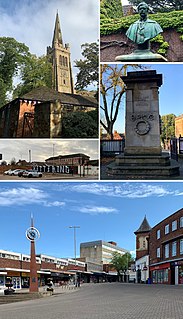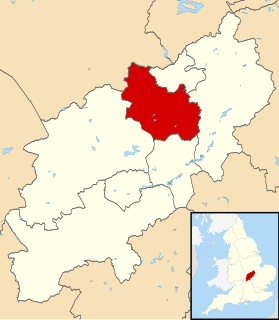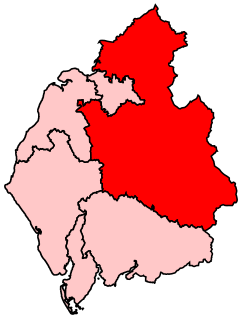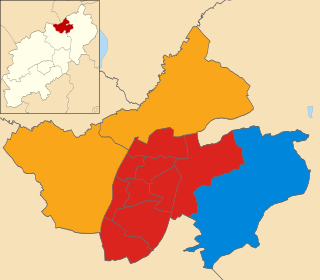
Northamptonshire is a county in the East Midlands of England. In 2015, it had a population of 723,000. The county is administered by two unitary authorities: North Northamptonshire and West Northamptonshire. It is known as "The Rose of the Shires".

Corby is a town in North Northamptonshire, England, located 23 miles (37 km) north-east of Northampton. From 1974 to 2021, the town served as the administrative headquarters of the Borough of Corby. At the 2011 Census, the built-up area had a population of 56,810, while the borough, which was abolished in 2021, had a population of 61,255.

Kettering is a market and industrial town in North Northamptonshire, England. It is located 83 miles (134 km) north of London and 15 miles (24 km) north-east of Northampton, west of the River Ise, a tributary of the River Nene. The name means "the place of Ketter's people ".

The Borough of Kettering was from 1974 to 2021 a local government district and borough in Northamptonshire, England. It was named after its main town Kettering where the council was based. It bordered onto the district of Harborough in the neighbouring county of Leicestershire, the borough of Corby, the district of East Northamptonshire, the district of Daventry and the borough of Wellingborough.

Corby is a constituency in Northamptonshire represented in the House of Commons of the UK Parliament since May 2015 by Tom Pursglove of the Conservative Party.

Penrith and The Border is a constituency in Cumbria represented in the House of Commons of the UK Parliament since 2019 by Neil Hudson, a Conservative.
Corby Borough Council was elected every four years. The council was abolished in 2021, with the area becoming part of North Northamptonshire.

The 2003 Corby Borough Council election took place on 1 May 2003 to elect members of Corby Borough Council in Northamptonshire, England. The Labour Party retained overall control of the council, which it had held continuously since 1979.

North Northamptonshire is one of two local authority areas in Northamptonshire, England. It is a unitary authority area forming about one half of the ceremonial county of Northamptonshire. It was created in 2021. Its notable towns are Kettering, Corby, Wellingborough, Rushden, Raunds, Desborough, Rothwell, Irthlingborough, Thrapston and Oundle. The council is based at the Corby Cube in Corby.

The 2015 Corby Borough Council election took place on 7 May 2015 to elect members of Corby Borough Council in Northamptonshire, England. This was on the same day as other local elections. The Labour Party retained control of the council, which it has held continuously since 1979.

The 2011 Corby Borough Council election took place on 5 May 2011 to elect members of Corby Borough Council in England. This was on the same day as other UK local elections. The Labour Party retained control of the council, which it had held continuously since 1979.

The 1999 Corby Borough Council election took place on 6 May 1999 to elect members of Corby Borough Council in Northamptonshire, England. It was the first election be held under new ward boundaries. The Labour Party retained overall control of the council, which it had held continuously since 1979.

The 1976 Corby District Council election took place on 6 May 1976 to elect members of Corby District Council in Northamptonshire, England. This was on the same day as other local elections. It was the first election be held under new ward boundaries. The Conservative Party gained overall control of the council from the Labour Party, for the first and only time in its history.

The 1979 Corby District Council election took place on 3 May 1979 to elect members of Corby District Council in Northamptonshire, England. This was on the same day as other local elections. The Labour Party regained overall control of the council which it had lost to the Conservative Party at the previous election in 1976. The council then remained continuously under Labour control until the day Corby District Council was abolished..

The 1983 Corby District Council election took place on 5 May 1983 to elect members of Corby District Council in Northamptonshire, England. This was on the same day as other local elections. The Labour Party retained overall control of the council, which it had gained at the previous election in 1979.

The 1991 Corby District Council election took place on 2 May 1991 to elect members of Corby District Council in Northamptonshire, England. This was on the same day as other local elections. The Labour Party retained overall control of the council, which it had held since 1979.

The 1995 Corby District Council election took place on 4 May 1995 to elect members of Corby Borough Council in Northamptonshire, England. This was on the same day as other local elections. The Labour Party retained overall control of the council, which it had held continuously since 1979.
The 1973 Corby District Council election were the first elections to the newly created Corby District Council took place on 7 June 1973. This was on the same day as other local elections. The Local Government Act 1972 stipulated that the elected members were to shadow and eventually take over from the predecessor corporation on 1 April 1974. The election resulted in Labour gaining control of the council.

The 1987 East Northamptonshire District Council election took place on 7 May 1987 to elect members of East Northamptonshire District Council in Northamptonshire, England. This was on the same day as other local elections. The Conservative Party retained overall control of the council which it had held since the council's creation in 1973.

Corby was a non-metropolitan district with borough status in the county of Northamptonshire, England. It bordered East Northamptonshire, Harborough, Kettering and Rutland. In 2011 the district had a population of 61,607. The council, Corby Borough Council was based at the Cube in the town of Corby.






























